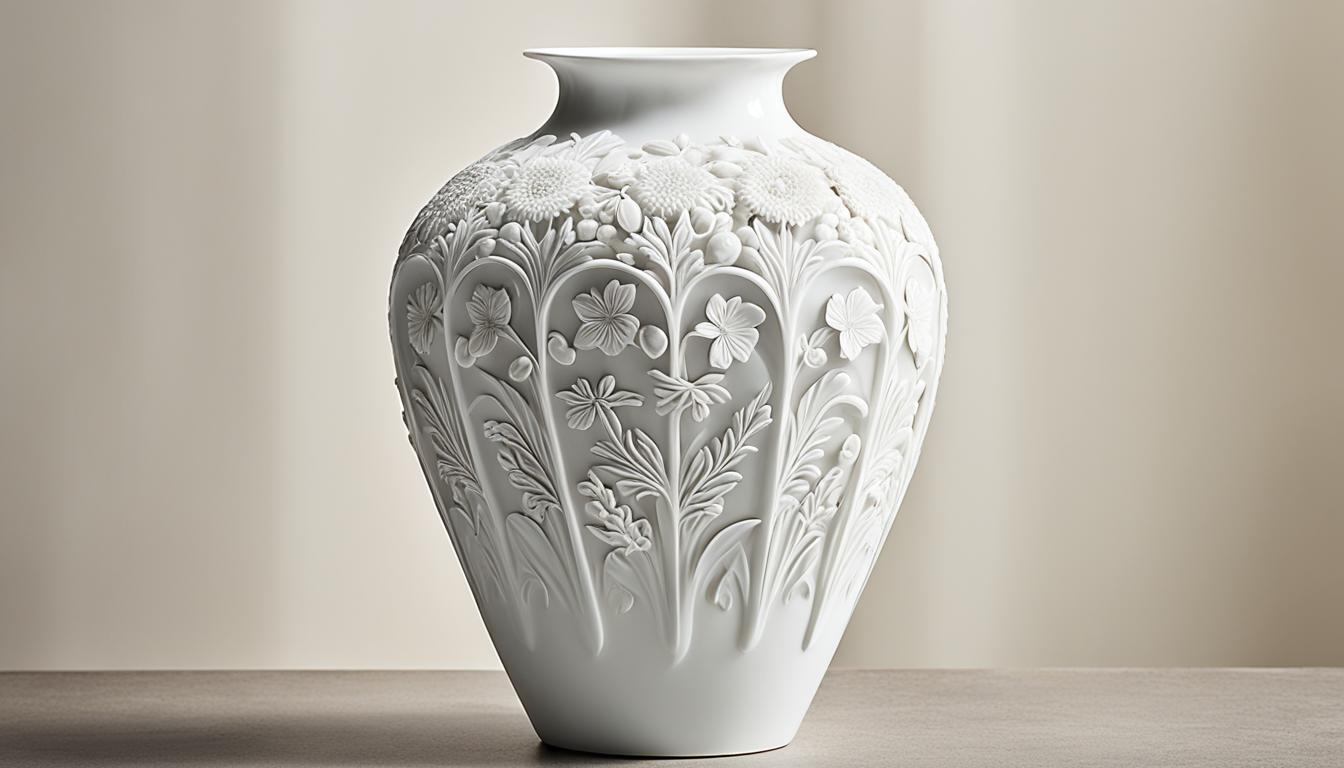Did you know porcelain flowers are great for people who live in apartments? They make any room look elegant and have benefits for indoor living. This guide will show you how to grow and care for porcelain flowers. Your apartment will look like an amazing indoor garden.
Key Takeaways
- Porcelain flowers are the perfect choice for apartments, adding beauty and elegance to any space.
- These indoor plants have air-purifying properties and can help improve the air quality in your apartment.
- Porcelain flowers are pet-friendly, making them safe for your furry friends to be around.
- Understanding the growth habits of porcelain flowers can help you manage their size and ensure they fit perfectly in your apartment.
- With the right care and attention, you can successfully grow and maintain porcelain flowers as stunning additions to your indoor garden.
Why Do We Love the Porcelain Flowers For Apartments?
Porcelain flowers are loved for indoor plants in apartments. They are unique and bring many benefits. These plants add beauty and charm to any home. And, they fit well in apartment living.
Is Porcelain Flowers Air-Purifying?
Yes! Porcelain flowers clean the air. They remove bad toxins. With these plants in your apartment, you breathe fresh air. It makes a healthier home for you and your family.
Is Porcelain Flowers Pet-Friendly?
Yes, they are! If you have pets, porcelain flowers are safe. You and your pets can enjoy their beauty. No need to worry about your furry friends.
How Big Do Porcelain Flowers Get?
Porcelain flowers vary in size. Choose based on your apartment’s space and look. There are small and large plants. Pick one that fits your home’s style.
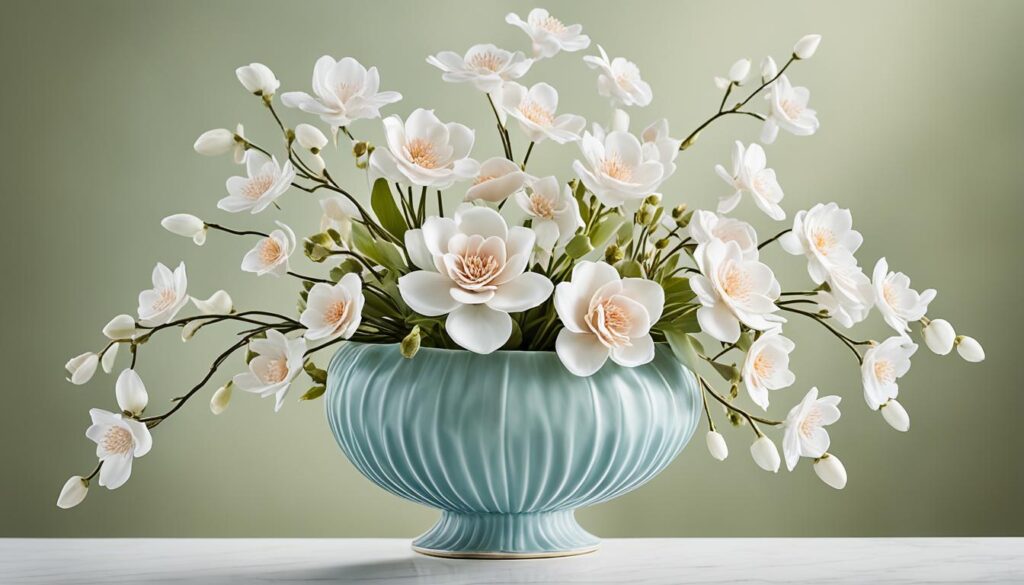
We know why people love porcelain flowers in apartments. Next, we will see how to grow them indoors.
How to Grow a Porcelain Flowers – Learn to Grow this Indoor Beauty
Growing porcelain flowers indoors needs care and attention. There are several key steps for healthy growth and blooms. These include choosing the right pot and soil, and getting the light and water right. Proper nutrition and looking after the plants well are also important.
Choosing the Right Pot and Soil
It’s vital to pick the right pot size and type for porcelain flowers. Make sure the pot has good drainage. Use a potting mix that keeps the right balance of moisture and air. This helps your flowers grow well.
Providing Adequate Light
Porcelain flowers do best in bright, indirect light. Keep them near a window, but out of direct sun. You can also use grow lights if there’s not enough natural light.
Watering and Humidity
Watering the right way is important. Let the top inch of soil dry a bit before watering. Then, water until it drains out the bottom. Porcelain flowers like it when it’s a bit humid. Try a humidifier, or put pots on water-filled trays with pebbles.
Nutrition and Fertilization
Fertilize your porcelain flowers regularly. Use a balanced fertilizer made for indoor plants. Follow what the package says for how much to use. Fertilize every two to four weeks when the plant is growing a lot. Do it less in winter.
Pruning and Maintenance
Trim your porcelain flowers to keep them looking nice. Cut off any bits that are dead or don’t look good. This helps new parts grow. Always check for pests or sickness and take care of any problems fast.
Propagation
You can make more porcelain flowers from your plants. Use stem cuttings, or split the plant into smaller parts. Each part should have its own roots and stems. This is a great way to get more plants.
Monitoring for Pests and Diseases
Watch your plants for bugs like aphids or spider mites. Also look for yellow leaves or spots. These could mean your plant is sick. If you find bugs or sickness, treat them right away.
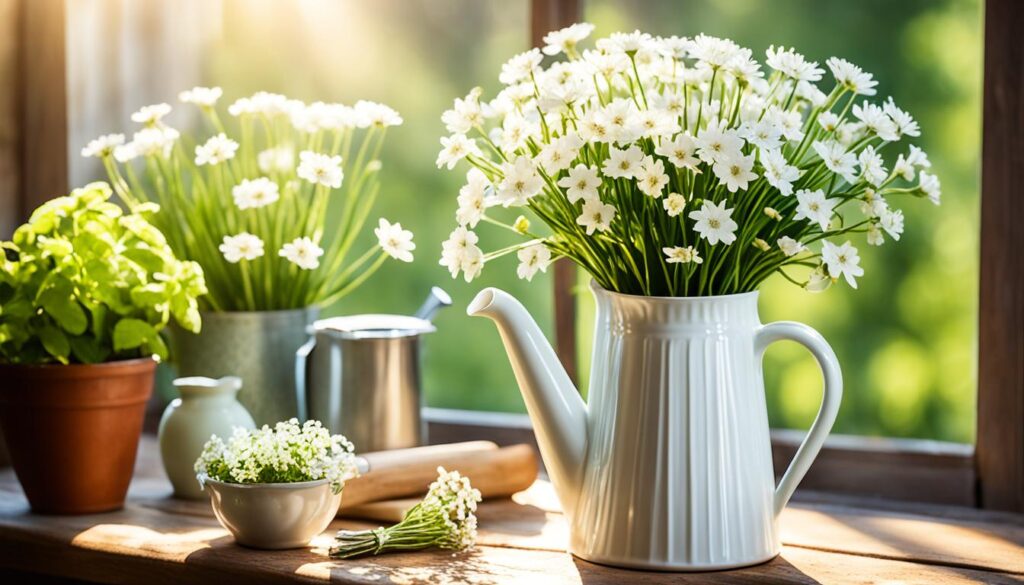
Follow these steps, and you can grow beautiful porcelain flowers inside. Make sure they have everything they need, like the right pot, enough light, and water. Also, keep them fed and well taken care of. Look out for pests and diseases too. With a bit of work, you can have a lovely indoor garden with porcelain flowers.
Appearance of Porcelain Flowers
Porcelain flowers are known for their stunning beauty. They have delicate and complex details that catch your eye. They come in many shapes, colors, and textures. This adds elegance to any place.
Porcelain flowers look a lot like real ones. They capture the shape and patterns of petals beautifully. Each flower is a masterpiece.
These flowers show many bright colors. You can find pink, white, blue, and purple ones. You can choose from soft or bold colors. Their colors look great with the green leaves.
The feel of porcelain flowers is also special. Some are smooth and shiny. Others feel velvety or waxy. This makes the flowers more interesting to look at.
Looking closely at porcelain flowers is amazing. You can see fine lines on the petals and tiny parts inside. The way they curve is beautiful.
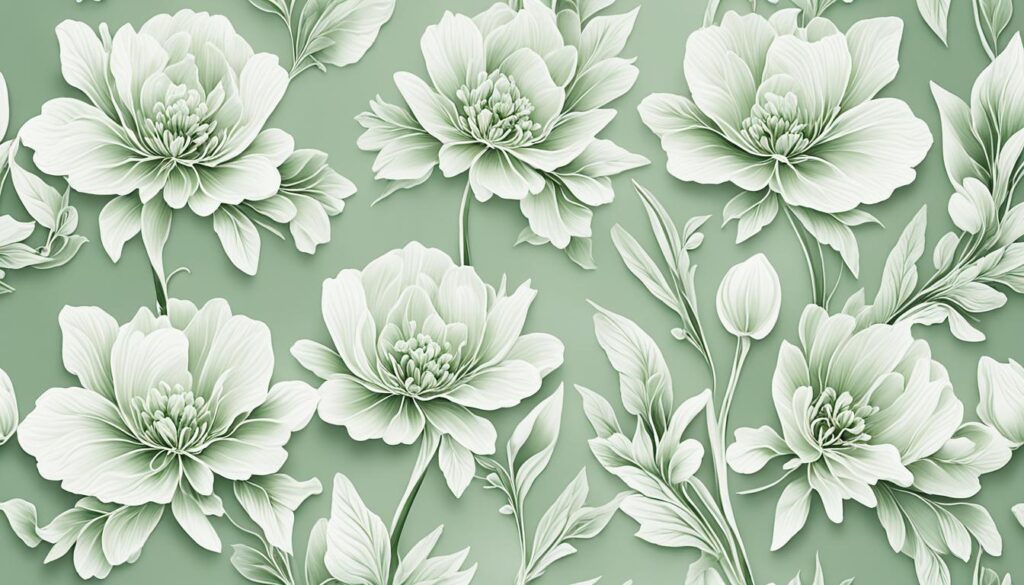
Light Requirements for Porcelain Flowers
Porcelain flowers need the right light to grow well. It’s key to know what light they need. This keeps them looking beautiful and healthy.
They love bright, indirect light the most. A spot near a window with filtered sun is perfect. Or a room that’s nicely lit up. But don’t let the sun hit them directly. It can hurt their leaves.
If you can’t avoid direct sun, use sheer curtains. They can soften the sun’s rays.
These flowers can handle less light than some plants. But too little light makes them weak. It also means not as many flowers. It’s important to find the right light balance.
Turn your flowers sometimes. This makes sure all sides get light. It keeps them growing evenly.
Different lights have different effects. Natural daylight is best. But if there’s not enough, use artificial lights. LED or full-spectrum fluorescent lights work well.
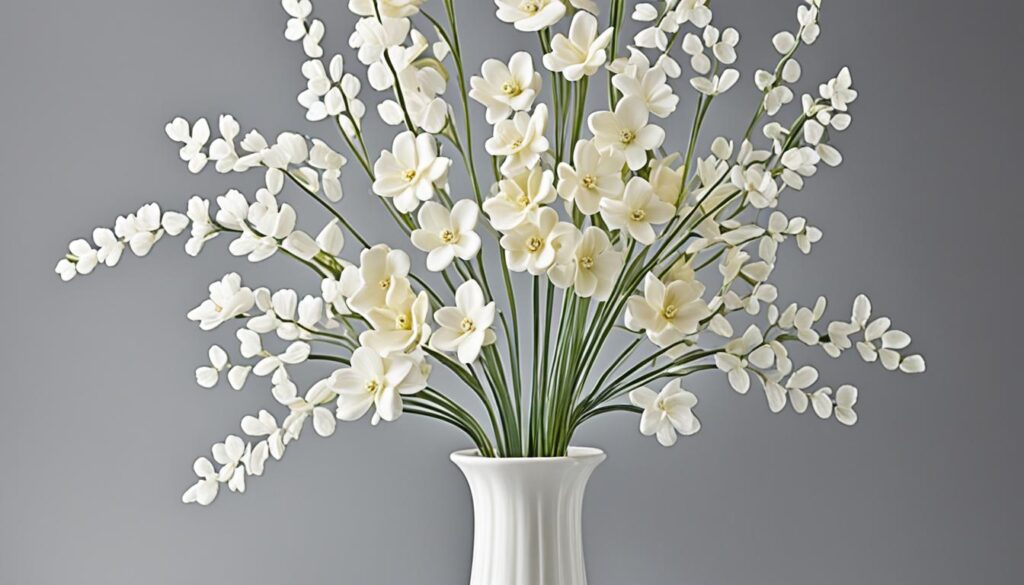
Watering Requirements of the Porcelain Flowers
Watering porcelain flowers right is very important. It helps them stay healthy and look pretty. Don’t water them too much or too little.
Finding the right balance when watering is crucial. Too much water causes root problems. Too little water makes them dry. Always check the soil to see if it’s wet or dry.
Signs of Overwatering
Too much water is bad for these plants. Here are signs:
- Yellowing or wilting leaves
- Soggy or waterlogged soil
- Mold or fungal growth
- Rotten or mushy roots
Signs of Underwatering
Not enough water also hurts them. Look for these signs:
- Drooping or shriveling leaves
- Dry or crumbly soil
- Leaf tips turning brown
- Slow growth or wilting
Watch the soil and see how the plants look. This tells you when to water. Water enough to keep the soil moist, but not wet.
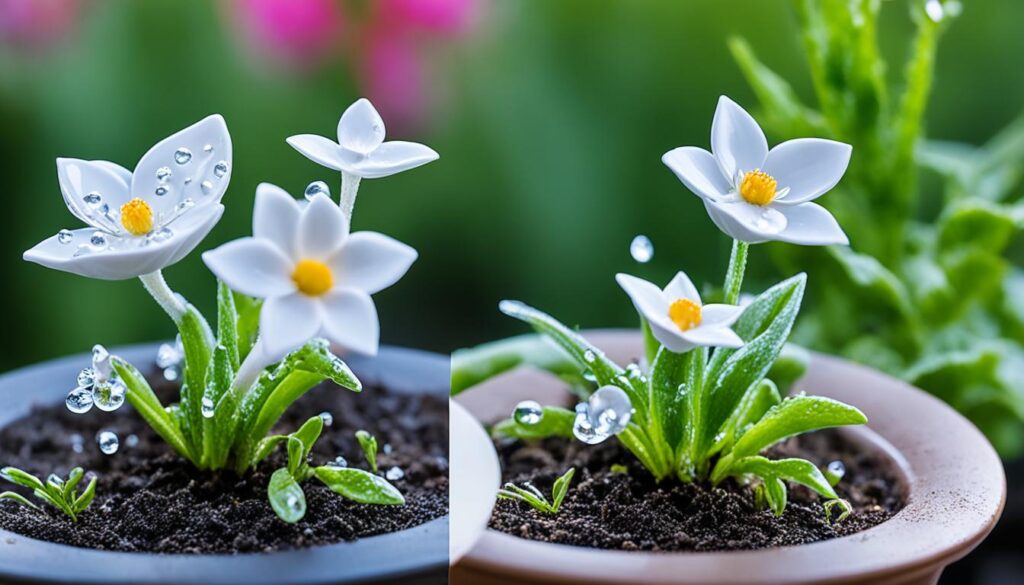
| Watering Tips | Frequency |
|---|---|
| Use a well-draining potting mix | Every 7-10 days, or when the top inch of soil feels dry |
| Water thoroughly until excess water drains out of the pot | Avoid letting water accumulate in the saucer |
| Consider the environmental conditions (temperature, humidity) when determining watering frequency | Adjust watering frequency during winter, when plants tend to require less water |
| Check the moisture level in the soil using a soil moisture meter or by inserting your finger about an inch into the soil | Monitor the moisture level to avoid overwatering or underwatering |
By sticking to these tips and watching for signs, your porcelain flowers will be healthy. Right watering is key to their beauty.
Fertilizing a Porcelain Flowers
Fertilizing is key for porcelain flowers to grow and bloom well. It ensures they look their best.
Recommended Fertilizer for Porcelain Flowers
Pick a fertilizer made for flowering houseplants. A 10-10-10 balanced mix works best for them.
“Blooming Bliss Plant Food” is a top choice for porcelain flowers. It helps flowers bloom brightly and grow strong.
Follow the package’s instructions when using fertilizer. Mix it with water and pour it near the plant’s base. Don’t get it on the leaves to avoid damage.
Don’t overuse fertilizer on porcelain flowers. Too much can harm them. Use it once a month when they’re growing.
In winter or when they’re not growing, cut back on fertilizer. They need less during these times.
Choosing the right fertilizer and using it correctly is important. It helps your porcelain flowers look amazing.
Potting a Porcelain Flowers
Ensuring your porcelain flowers grow well means potting them right. I’ll show you how. We’ll cover the right pot size, the best potting mix, and when to repot.
Choosing the Right Pot Size
The pot’s size is key for your flowers’ growth. It must let roots spread and drain well. Pick a pot 2 inches wider than your plant. This rule helps a lot.
Using the Right Potting Mix for Porcelain Flowers
A good potting mix is crucial too. It should drain well but hold nutrients. Use a mix made for indoor plants or succulents. It’s best for porcelain flowers.
Repotting When Necessary
Sometimes, your flowers will need a new pot. Look for roots out the drainage holes or if water sits on the soil. When repotting, be gentle with the plant. Choose a slightly bigger pot. Always use new potting mix.
Water well after repotting. This helps your plant settle in. Following these steps will make your porcelain flowers bloom beautifully.
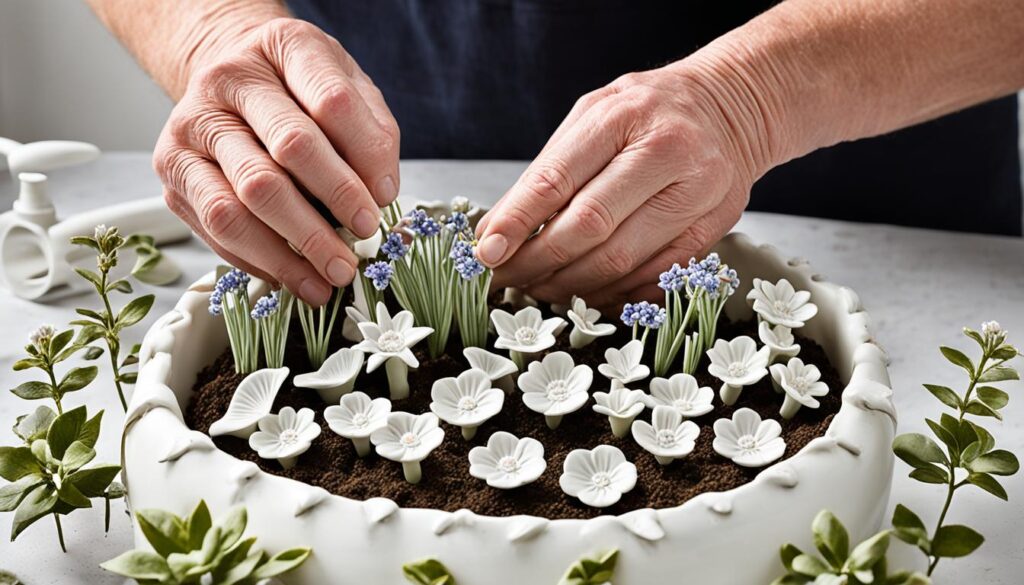
Propagating a Porcelain Flowers
Propagating porcelain flowers is fun. It lets you grow your collection or share with friends. You can use stem cuttings or division to do this.
Stem Cuttings Or Seeds?
Stem cuttings are a common way to propagate porcelain flowers. You take a healthy stem from a parent plant. Then, you make it root and grow into a new plant.
Here’s how to propagate with stem cuttings:
- Choose a healthy stem without damage or disease.
- Cut the stem below where a leaf joins the stem.
- Take off lower leaves, keeping a few at the top.
- Dip the stem end in rooting hormone to help roots grow.
- Plant the stem in good soil. Give it light, water, and humidity.
Growing from seeds is another way. This lets you grow new plants from the start.
Steps for using seeds are:
- Pick mature seeds when they’re ready.
- Get a tray ready with good soil for seeds.
- Spread seeds on soil and press lightly.
- Cover seeds with a bit of soil or vermiculite.
- Keep soil moist and warm. Make sure it gets enough light.
- When seedlings have a few real leaves, move them to pots or a big container.
Division Of A Porcelain Flowers
Division is good for big plants with lots of parts. It’s another way to make more plants.
Here’s how to do it:
- Take the big plant out of its pot or the ground.
- Find the parts of the plant that can grow on their own.
- Make sure each part has some roots.
- Put each part in its own place. Take good care of it.
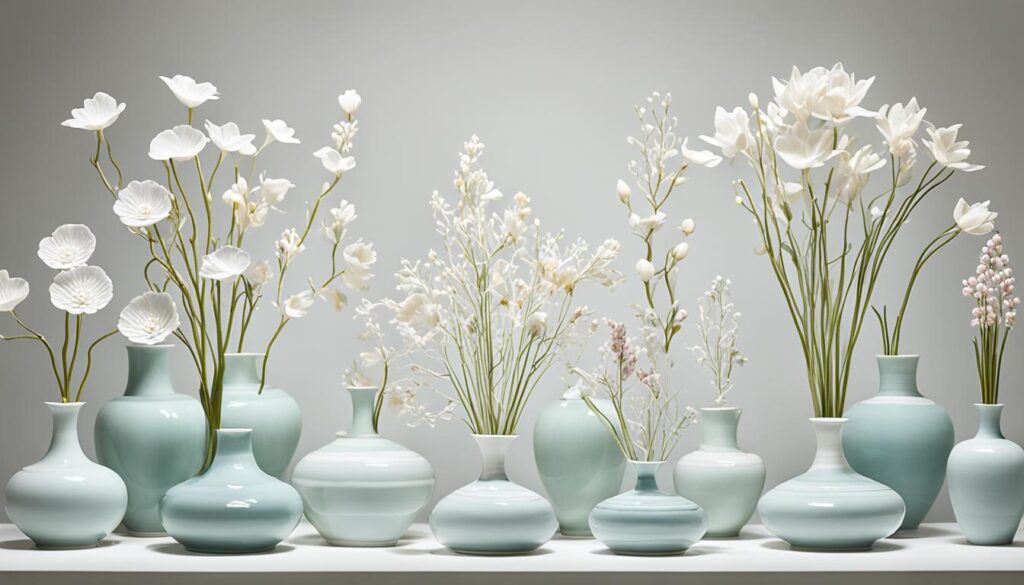
Propagating lets you make new plants. It feels great and makes places look pretty. You can use cuttings, seeds, or divide plants. Any way you choose, it brings happiness to plant lovers.
Growth and Development of the Porcelain Flowers
It’s important to know how porcelain flowers grow. This helps you take good care of these stunning plants. Learn about their growth stages and what they need. Then, you can make sure they grow well and bloom a lot.
Porcelain flowers start from seeds or cuttings. They grow roots that help the plant stay healthy. In the beginning, the plant makes lots of leaves and gets strong.
Light, warmth, wetness, and food are very important for these flowers. They need the right light, warm and moist surroundings, and good food to grow right.
When they’re ready, porcelain flowers start to bloom. Their flowers are pretty and detailed. To help them bloom, they need the right light and food.
If you take good care of them, porcelain flowers will keep growing and blooming. They make any room look better. Know how they grow to keep them happy and beautiful.
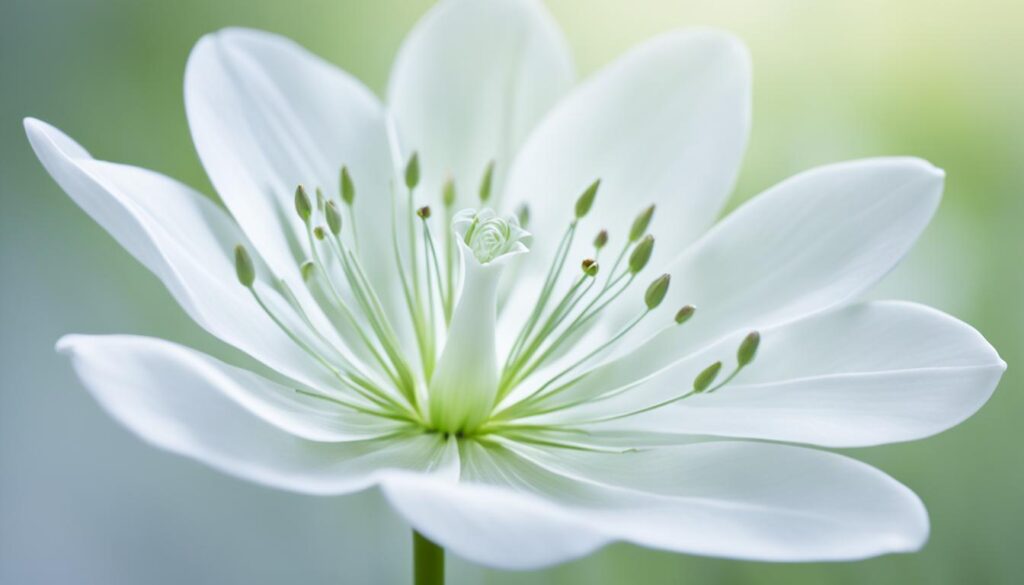
Dealing with Pests and Diseases in the Porcelain Flowers
Porcelain flowers can get sick like any other plant. They can get pests and diseases. It’s very important to know which pests and diseases could harm your porcelain flowers. Knowing how to spot the signs lets you take care of your flowers well.
Identifying Pests
Aphids, spider mites, and mealybugs might bother your porcelain flowers. Aphids are tiny bugs that eat plant sap. They make leaves look odd and slow down growth. Spider mites are small spiders that spin webs on leaves, causing yellowing and drooping. Mealybugs look like small, white fluff spots. They suck the sap and can make the leaves yellow, droop, or sticky.
Check your flowers often for any odd signs like twisted leaves, webs, or white spots. If you see pests, it’s important to act fast to keep them from harming your flowers more.
Managing Pests
To take care of pests on your porcelain flowers:
- Prune: Cut off the sick parts of the plant if the problem is small.
- Natural remedies: Use homemade bug spray or neem oil. They work well on aphids, spider mites, and mealybugs.
- Biological control: You can also use helpful bugs like ladybugs or lacewings. They eat the bad pests.
- Isolation: If just one plant is sick, keep it away from the others. This helps stop the pests from spreading.
Preventing Diseases
To keep your porcelain flowers from getting sick:
- Provide proper air circulation: Make sure your plants aren’t too close. They need air to stay healthy.
- Watering: Don’t give them too much water. Wet leaves can lead to fungus diseases. Always water the base of the plant.
- Maintain cleanliness: Clean up fallen leaves and trash around your flowers. This helps keep diseases away.
- Use disease-resistant varieties: Choose porcelain flowers that don’t get sick easily for your garden.
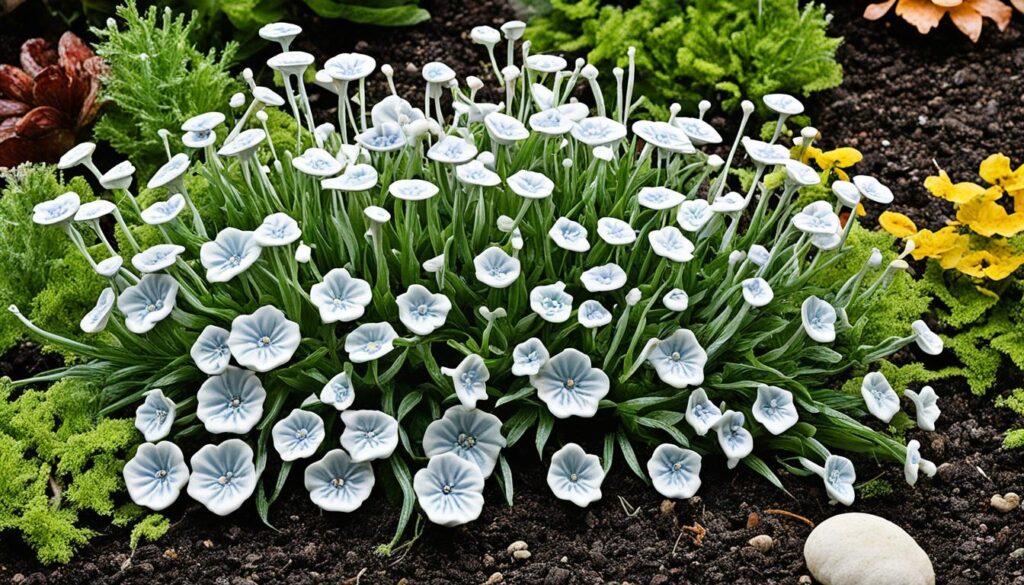
Stay ahead of problems by keeping an eye on your flowers and acting quickly when needed. Regular care keeps your porcelain flowers healthy and beautiful.
Common Porcelain Flowers Pests
It’s key to know the pests that can harm your porcelain flowers. Knowing them helps you keep your flowers healthy.
Some pests can hurt your flowers a lot. They might stop their growth or damage their leaves. Some can even kill the plants.
Here are the pests to look out for:
- Aphids: Tiny bugs that eat sap and make leaves yellow and weird-shaped.
- Mealybugs: Small, fuzzy bugs that live in plant joints and eat sap, making plants weak.
- Spider Mites: Tiny invisible bugs that make webs on leaves and eat sap, causing yellow and spotted leaves.
- Scale Insects: Tiny, oval bugs that stick to plants and eat sap, leading to yellowed and droopy leaves.
- Whiteflies: Small flying bugs that live under leaves, eat sap and can spread diseases.
Keeping these pests away is vital for your flowers’ health and looks. Here’s how you can fight off these infestations:
- Organic methods: Use insecticidal soaps or oils to kill pests. Neem oil is a good natural bug spray.
- Biological control: Add good bugs like ladybugs to eat the bad ones.
- Pruning and cleaning: Check your plants and remove any parts that bugs have infected to stop them from spreading.
- Chemical treatments: If bugs are really bad and nothing else works, you might use chemical sprays. But you must be careful not to hurt your plants or the earth.
| Pest | Description | Damage |
|---|---|---|
| Aphids | Small insects that feed on sap | Distorted leaves, yellowing |
| Mealybugs | Fuzzy pests that cluster in joints | Weakened plants |
| Spider Mites | Nearly invisible pests that create webs | Yellowing, mottled leaves |
| Scale Insects | Tiny oval-shaped pests that attach to plants | Yellowing, wilting leaves |
| Whiteflies | Small winged insects that cluster on undersides of leaves | Sap feeding, viral disease transmission |
Natural Predators
Natural predators help control pests in porcelain flowers. They keep your plants healthy. By using nature, you avoid too much chemical use.
Isolate Infected Plants
If you see pests, separate sick plants right away. This stops pests from spreading. It keeps your garden safe and healthy.
Chemical Treatment
Sometimes, you might need chemicals for pests. Only do this when really needed. Always follow the instructions. Use the right product for your pests. Be safe and think about the environment.
Disease Prevention For Porcelain Flowers
Keeping your porcelain flowers healthy is important. This means preventing diseases before they start. To do this, learn what sicknesses can hurt your plants. Then, use the right steps to keep them safe. This makes sure your porcelain flowers stay bright and alive for a long time.
Diseases that can harm porcelain flowers include fungi, viruses, and bacteria. These can make plants wilt, change color, get spots on leaves, or not grow right. To stop these diseases, keep your plants in a clean place.
Here are good ways to prevent diseases in porcelain flowers:
- Proper sanitation: Clean your garden tools, pots, and trays often. Get rid of sick plant parts the right way to stop diseases from spreading.
- Avoid overwatering: Too much water can make fungi grow. Make sure your plants have good drainage. Water them just enough. Let the soil dry a bit before watering again.
- Air circulation: Plants need fresh air to stay healthy. Don’t put them too close together. This helps keep them dry and stops fungi from growing.
- Quarantine new plants: Keep new plants away from others at first. Watch them for any disease signs. This keeps your healthy porcelain flowers safe.
- Inspect regularly: Check your porcelain flowers often for disease or bugs. Finding problems early can stop them from getting worse. This helps you take care of them right away.
“Prevention is key when it comes to diseases in porcelain flowers. By maintaining a clean and sanitary environment, practicing proper watering techniques, and inspecting your plants regularly, you can keep your porcelain flowers thriving.”
Prevention is better than cure for diseases in porcelain flowers. Using these practices in your garden will let you enjoy healthy and pretty porcelain flowers for a long time.
Tips for Maintaining Porcelain Flowers
To keep your porcelain flowers beautiful, follow these tips. This will ensure they stay healthy and look great. Avoid exposing them to direct sunlight, as this can cause fading over time. Additionally, consider displaying them alongside some elegant accessories, such as jade necklace varieties and types, which can enhance their aesthetic appeal and create a stunning visual contrast. Regular dusting will also help maintain their shine and prevent any buildup that could detract from their beauty.
Wiping Leaves
It’s important to clean the leaves regularly. Use a soft cloth or sponge to gently remove dust. This makes the plants look better and helps them “breathe.” Make sure the leaves are dry before cleaning them.
Outdoor Exposure
Porcelain flowers do well inside but like some outdoor time too. Being outside helps them grow strong. Just be careful with the weather. Start with short outdoor stays and slowly increase them.
Adjusting Watering Schedule
Watering your flowers right is very important. Think about the weather and how dry the soil is. Don’t water too much to avoid problems. Water them when the soil’s top inch is dry.
Keep these tips in mind to have happy, healthy porcelain flowers.
Tips for Successful Overwintering of Porcelain Flowers
Keeping porcelain flowers alive in winter is tough, especially in cold places. Yet, the right steps can keep your porcelain flowers safe all winter. This way, you can enjoy their beauty every year.
Want to keep your porcelain flowers alive during winter? Here are some easy tips:
- Choose the right location: Find a good spot for your flowers before winter. Pick a place safe from strong winds and very cold weather. Putting them near a window that faces south or in a greenhouse is smart. This gives them the light and warmth they need.
- Monitor temperature and humidity: Porcelain flowers don’t like temperature shifts. So, keep track of the indoor temperature and humidity. Cold drafts or too-dry air can hurt them. Use a humidifier or put a water tray nearby to help.
- Reduce watering: In winter, porcelain flowers sleep and need less water. Watering too much can harm them. Wait until the top inch of the soil is dry before watering again.
- Provide adequate light: They need less light in winter but still, need some to stay healthy. Keep them where it’s bright but away from direct sun, which can harm their leaves. Use artificial lights if you must.
- Protect from pests: Porcelain flowers usually fight off bugs well, but stay alert in winter. Check your plants often for pests like mealybugs or spider mites. Use safe insect soap or natural methods if you find bugs.
These tips will help keep your porcelain flowers safe in winter. Then, you can enjoy their beauty for many years.
Growing Porcelain Flowers from Seed
Growing these flowers from seed is fun and rewarding. You can plant them from the start. This lets you explore different kinds and make your own unique garden. Here’s how to do it:
- Obtain high-quality seeds: Get fresh seeds from a good supplier. Make sure they are for the type you want.
- Prepare the planting medium: Use a potting mix that drains well. Fill trays or pots with it and add some water.
- Sow the seeds: Put the seeds on the mix. Press them down to touch the soil.
- Provide optimal conditions: Place them where it’s warm but not in direct sun. Keep it at 70-75°F (21-24°C).
- Keep the soil moist: Water with a misting bottle or fine spray. The soil should be moist, not too wet.
- Be patient: It might take days or weeks for seeds to sprout. Just wait and keep conditions right.
- Transplant the seedlings: When they have real leaves, move them to pots. Be gentle with their roots.
- Nurture the young plants: Keep them in a bright spot without direct sun. Water regularly and make sure air can flow.
- Harden off and transplant: Get them used to outside over 1-2 weeks. After frost, move them outside or to big pots.
- Continue care and maintenance: Take care of grown flowers. Watch for bugs, give them water and light, and feed them when needed.
With some patience and care, you’ll get to see your porcelain flowers bloom. It’s a great feeling!
Varieties of Porcelain Flowers
The world of porcelain flowers is vast and diverse. There are many colors, sizes, and types.
The Hoya carnosa, or Wax Plant, is popular. It has star-shaped flowers in pink, white, and red.
The Pleiospilos nelii, known as Split Rock, looks like a stone. It has bright yellow flowers.
The Stephanotis floribunda, or Madagascar Jasmine, is a big vine plant. It has fragrant white flowers.
The Impatiens niamniamensis, or Parrot Plant, is very unique. Its blooms are red, purple, and orange, like a parrot.

